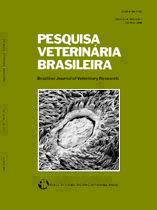 |
|
|
|
Year 2013 - Volume 33, Number 1001
|

|
Comparative ultrastructure of the tongue of black-tufted-ear-marmoset (Callithrix penicillata) and black-howler-monkey (Alouatta caraya) in different age groups, 33(Supl.1):75-84
|
ABSTRACT.- Nitta C.Y., Silva L.C.S., Miglino M.A., Ambrosio C.E., Bombonato P.P. & Rici R.E.G. 2013. [Comparative ultrastructure of the tongue of black-tufted-ear-marmoset (Callithrix penicillata) and black-howler-monkey (Alouatta caraya) in different age groups.] Ultraestrutura comparativa da língua do sagui-de-tufo-preto (Callithrix penicillata) e do bugio-preto (Alouatta caraya) em diferentes faixas etárias. Pesquisa Veterinária Brasileira 33(Supl.1):75-84. Faculdade de Medicina Veterinária e Zootecnia, Universidade de São Paulo, Av. Prof. Orlando Marques de Paiva 87, Cidade Universitária, São Paulo, SP 05508-270, Brazil. E-mail: cayo.nitta@usp.br
For the comparative analysis and description of the morphology of the tongue and taste buds as well as the distribution of these we have used three animals of different age groups (puppy, young adult), of two species of primate, Callithrix penicillata (black-tufted-ear-marmoset) and Alouatta caraya (black-howler-monkey), both being observed by scanning electron microscopy. The animals of the species Callithrix penicillata were from a commercial breeding of wild animals in Atibaia-SP and they had died of natural causes, and the specie Alouatta caraya were from the collection of Macroscopic Anatomy Laboratory of Faculty of Veterinary Medicine and Animal Science University of São Paulo (FMVZ-USP). With the material analyzed and the technique employed could be seen that the tongue of black-tufted-ear-marmosets and black-howler-monkeys had examined lingual papillae similar to those described for other primate species. The tongue has morphological differences, especially for some types of lingual papillae, at the expense of advancing age of the animals. Overall, we found four types of lingual papillae, which are: filiform, fungiform, vallate and litter. The tongues of the black-howler-monkey had characteristics of animals with herbivorous diets. Possessing this way with the filiform papillae varied formats (crown, spear, multifilament), according to the regions of the tongue, and also robust taste, especially in the lingual prominence. Since the tongues of the black-tufted-ear-marmosets owned features of omnivorous animals. With filiform-shaped crown, large amounts of fungiform papillae and foliate papillae developed. It was observed that the changes of tongue papillae that occur in animals after birth correlated with the change in the types of foods consumed. Being suspected then conclude that diets have direct relation to the morphological and structural of the lingual papillae now here in the animals analyzed. |
| |
|
|
| |
|
 |